Sheet Metal Market
Sheet Metal Market Size and Share Forecast Outlook 2025 to 2035
Sheet metal market is projected to grow from USD 430.0 billion in 2025 to USD 560.0 billion by 2035, at a CAGR of 2.7%. Carbon Steel will dominate with a 52.0% market share, while automotive & transport will lead the end use segment with a 38.0% share.
Sheet Metal Market Forecast and Outlook 2025 to 2035
The global sheet metal market is valued at USD 430.0 billion in 2025 and is projected to reach USD 560.0 billion by 2035, recording an absolute increase of USD 130.0 billion over the forecast period. This translates into a total growth of 30.2%, with the market expected to expand at a compound annual growth rate (CAGR) of 2.7% between 2025 and 2035.
The overall market size is anticipated to grow by nearly 1.3X, driven by rising infrastructure development, increasing automotive production, and growing demand for manufacturing and construction applications across diverse sectors including industrial machinery, consumer goods, and transportation.
Quick Stats for Sheet Metal Market
- Sheet Metal Market Value (2025): USD 430.0 billion
- Sheet Metal Market Forecast Value (2035): USD 560.0 billion
- Sheet Metal Market Forecast CAGR: 2.7%
- Leading Material in Sheet Metal Market: Carbon steel
- Key Growth Regions in Sheet Metal Market: Asia Pacific, North America, and Europe
- Key Players in Sheet Metal Market: ArcelorMittal, Nippon Steel, POSCO, Baowu Steel Group, JFE Steel, Tata Steel
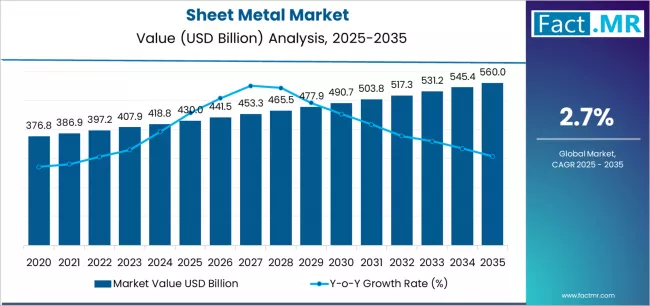
One of the key drivers of the market is the expanding construction and infrastructure sector, particularly in emerging economies. Urbanization, government-backed smart city initiatives, and large-scale public infrastructure projects are driving demand for structural sheet metal components used in buildings, bridges, and commercial complexes. Additionally, lightweight and corrosion-resistant sheet metals are increasingly preferred in modern construction practices to enhance durability and reduce maintenance costs.
The automotive and transportation industry remains another crucial growth segment. Rising production of electric vehicles (EVs), lightweight car frames, and commercial vehicles is stimulating demand for aluminum, steel, and high-strength sheet metals. Automotive manufacturers are increasingly adopting advanced metal forming techniques such as stamping, laser cutting, and hydroforming to meet design and safety standards while optimizing material efficiency. The ongoing trend toward lightweighting for fuel efficiency and sustainability further supports sheet metal consumption in this sector.
Industrial machinery and manufacturing applications also contribute significantly to market growth. Sheet metals are widely used in the fabrication of equipment, enclosures, panels, and components across sectors such as aerospace, defense, energy, and heavy machinery. The adoption of automated manufacturing, robotic welding, and precision fabrication technologies is enhancing the efficiency and scalability of sheet metal production, enabling manufacturers to meet the growing demand for customized and high-quality components.
From a regional perspective, Asia-Pacific is expected to dominate the sheet metal market, fueled by industrialization, rapid urbanization, and a strong manufacturing base in countries like China, India, Japan, and South Korea. Meanwhile, North America and Europe will continue to maintain steady growth due to ongoing infrastructure upgrades, automotive innovations, and stringent quality standards in industrial applications.
Technological advancements in metal forming, coating, and finishing processes are expected to drive product innovation and efficiency. Developments in recyclable and sustainable sheet metals will also align with the increasing focus on environmental responsibility and circular economy practices. Moreover, the integration of Industry 4.0 solutions, including AI-based predictive maintenance and smart manufacturing systems, will improve production throughput and reduce operational costs for sheet metal manufacturers.
Overall, the sheet metal market is poised for steady and sustainable growth through 2035, supported by industrial expansion, automotive production, and infrastructure development. Companies investing in advanced production technologies, sustainable materials, and diversified product portfolios will be well-positioned to capitalize on long-term opportunities in this evolving global market.
Between 2025 and 2030, the sheet metal market is projected to expand from USD 430.0 billion to USD 485.8 billion, resulting in a value increase of USD 55.8 billion, which represents 42.9% of the total forecast growth for the decade. This phase of development will be shaped by increasing construction activities, rising automotive production, and growing industrial manufacturing demands.
Steel producers and metal processing companies are expanding their sheet metal production capabilities to address the growing demand for versatile and reliable metal products that ensure structural integrity and manufacturing efficiency.
Sheet Metal Market Key Takeaways
| Metric | Value |
|---|---|
| Estimated Value in (2025E) | USD 430.0 billion |
| Forecast Value in (2035F) | USD 560.0 billion |
| Forecast CAGR (2025 to 2035) | 2.7% |
From 2030 to 2035, the market is forecast to grow from USD 485.8 billion to USD 560.0 billion, adding another USD 74.2 billion, which constitutes 57.1% of the overall ten-year expansion. This period is expected to be characterized by the expansion of advanced manufacturing technologies, the development of high-strength steel grades, and the growth of specialized applications for renewable energy and electric vehicle sectors. The growing adoption of automation and Industry 4.0 technologies will drive demand for sheet metal with enhanced properties and precision manufacturing capabilities.
Between 2020 and 2025, the sheet metal market experienced steady growth, driven by infrastructure development requirements and growing recognition of sheet metal as essential material for enabling diverse manufacturing and construction applications across automotive, construction, and industrial sectors. The market developed as manufacturers recognized the potential for sheet metal technology to provide structural strength, support design flexibility, and enable cost-effective production while meeting stringent quality and performance requirements. Technological advancement in steel production and processing methods began emphasizing the critical importance of maintaining material consistency and cost-effectiveness in challenging market environments.
Why is the Sheet Metal Market Growing?
Market expansion is being supported by the increasing global infrastructure development driven by urbanization and economic growth, alongside the corresponding need for versatile metal materials that can enhance structural performance, enable manufacturing efficiency, and maintain cost-effectiveness across various automotive, construction, machinery, and industrial applications. Modern manufacturers and construction companies are increasingly focused on implementing sheet metal solutions that can provide structural reliability, support design flexibility, and ensure operational efficiency while meeting comprehensive performance and cost requirements.
The growing emphasis on manufacturing automation and precision fabrication is driving demand for sheet metal that can support advanced manufacturing processes, enable high-precision applications, and ensure comprehensive quality control. Industrial manufacturers' preference for materials that combine structural performance with processing efficiency and cost competitiveness is creating opportunities for innovative sheet metal implementations. The rising influence of renewable energy development and electric vehicle production is also contributing to increased adoption of sheet metal solutions that can provide performance benefits without compromising manufacturing efficiency or cost-effectiveness.
Segmental Analysis
The market is segmented by material, process, and end use. By material, the market is divided into carbon steel, stainless steel, and aluminium & others. Based on process, the market is categorized into rolling, pressing & stamping, and cutting & fabrication. By end use, the market includes automotive & transport, construction, and machinery & others. Regionally, the market is divided into North America, Europe, Asia Pacific, Latin America, and Middle East & Africa.
By Material, the Carbon Steel Segment Leads the Market
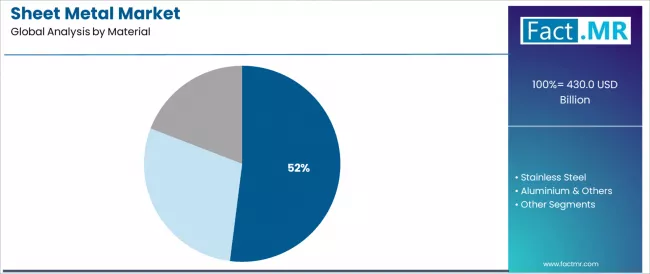
The carbon steel segment is projected to maintain its leading position in the sheet metal market in 2025 with a 52.0% market share, reaffirming its role as the preferred material category for structural applications and cost-effective manufacturing requirements. Manufacturing companies increasingly utilize carbon steel sheet metal for its proven strength characteristics, established cost-effectiveness, and demonstrated reliability in providing structural performance while supporting diverse fabrication methods and application requirements. Carbon steel technology's established performance and widespread availability directly address the industry requirements for reliable structural materials and comprehensive manufacturing solutions across diverse industrial sectors and processing conditions.
This material segment forms the foundation of modern metal fabrication, as it represents the steel grade with the greatest contribution to structural applications and established commercial acceptance across multiple manufacturing processes and global markets. Industrial investments in steel-based manufacturing continue to strengthen adoption among fabricators and designers. With growing demands for cost-effective structural solutions and manufacturing efficiency, carbon steel sheet metal aligns with both performance requirements and economic objectives, making it the central component of comprehensive metal fabrication strategies.
By End Use, the Automotive & Transport Segment Dominates Market Demand
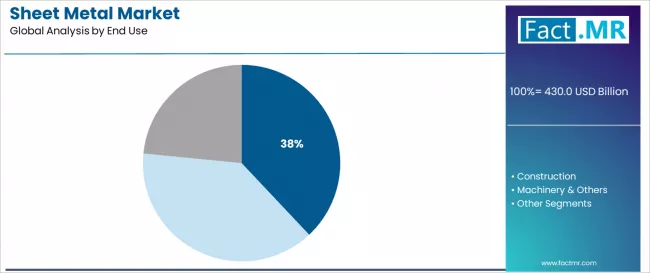
The automotive & transport end use segment is projected to represent the largest share of sheet metal demand in 2025 with a 38.0% market share, underscoring its critical role as the primary driver for sheet metal adoption across vehicle manufacturing, body panel production, and transportation equipment applications. Automotive manufacturers prefer sheet metal for its exceptional formability characteristics, proven crashworthiness performance, and ability to support lightweighting objectives while maintaining safety requirements and cost-effectiveness. Positioned as essential materials for modern automotive manufacturing, sheet metal offers both structural advantages and manufacturing flexibility.
The segment is supported by continuous innovation in automotive manufacturing and the growing availability of advanced high-strength steel grades that enable superior performance with enhanced safety characteristics and weight optimization. Additionally, automotive manufacturers are investing in comprehensive material optimization programs to support increasingly stringent safety regulations and fuel efficiency requirements. As automotive technology advances and performance standards increase, the automotive & transport segment will continue to dominate the market while supporting advanced sheet metal utilization and manufacturing optimization strategies.
What are the Drivers, Restraints, and Key Trends of the Sheet Metal Market?
The sheet metal market is advancing steadily due to increasing demand for structural materials driven by infrastructure development and growing adoption of advanced manufacturing technologies that require versatile metal products providing structural strength, fabrication flexibility, and cost-effectiveness across diverse automotive, construction, machinery, and industrial applications. However, the market faces challenges, including volatile raw material costs and commodity price fluctuations, competition from alternative materials and manufacturing methods, and supply chain constraints related to steel production capacity and transportation logistics. Innovation in steel grades and processing technologies continues to influence product development and market expansion patterns.
Expansion of Electric Vehicle Production and Lightweight Applications
The growing adoption of electric vehicles is driving demand for sheet metal applications that address weight reduction requirements, battery housing needs, and structural optimization objectives while maintaining safety standards and cost-effectiveness. Electric vehicle manufacturers require sheet metal solutions with enhanced strength-to-weight ratios, proven electrical compatibility, and specialized forming capabilities that enable innovative vehicle architectures. Automotive companies are increasingly recognizing the competitive advantages of advanced sheet metal integration for electric vehicle development and performance optimization, creating opportunities for specialized steel grades designed for next-generation mobility applications and sustainable transportation systems.
Integration of Industry 4.0 and Advanced Manufacturing Technologies
Modern sheet metal processors are incorporating automation systems and digital manufacturing technologies to enhance production efficiency, improve quality consistency, and support comprehensive manufacturing optimization through integrated process control and data analytics platforms. Leading companies are developing smart manufacturing capabilities, implementing predictive maintenance systems, and advancing processing technologies that maximize productivity while maintaining quality standards and cost competitiveness. These technologies improve manufacturing efficiency while enabling new market opportunities, including customized products, rapid prototyping services, and high-precision fabrication solutions. Advanced manufacturing integration also allows processors to support comprehensive operational excellence objectives and competitive differentiation beyond traditional cost and quality considerations.
Development of High-Strength Steel Grades and Advanced Alloys
The expansion of demanding applications and performance requirements is driving demand for sheet metal with enhanced mechanical properties, improved formability characteristics, and specialized chemical compositions that exceed traditional carbon steel specifications. These advanced applications require specialized steel grades with enhanced strength specifications and processing capabilities that support innovative design solutions, creating premium market segments with differentiated value propositions. Manufacturers are investing in metallurgical research and advanced steel production technologies to serve emerging high-performance applications while supporting innovation in automotive safety, construction efficiency, and industrial equipment optimization.
Analysis of the Sheet Metal Market by Key Countries
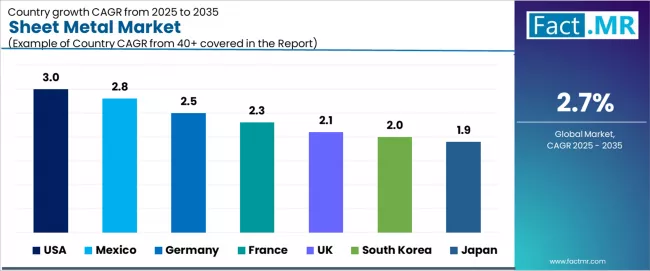
| Country | CAGR (2025-2035) |
|---|---|
| USA | 3.0% |
| Mexico | 2.8% |
| Germany | 2.5% |
| France | 2.3% |
| UK | 2.1% |
| South Korea | 2.0% |
| Japan | 1.9% |
The sheet metal market is experiencing moderate growth globally, with the USA leading at a 3.0% CAGR through 2035, driven by expanding infrastructure investment, growing automotive production, and increasing manufacturing activities supported by domestic steel production capabilities and advanced fabrication technologies. Mexico follows at 2.8%, supported by rapid automotive manufacturing expansion, growing construction activities, and increasing investment in industrial development projects.
Germany shows growth at 2.5%, emphasizing automotive engineering excellence, construction industry strength, and advanced manufacturing capabilities. France demonstrates 2.3% growth, supported by automotive industry development, infrastructure modernization, and comprehensive manufacturing capabilities. The UK records 2.1%, focusing on manufacturing modernization, construction activities, and advanced fabrication technologies.
South Korea exhibits 2.0% growth, emphasizing automotive production, shipbuilding capabilities, and industrial manufacturing excellence. Japan shows 1.9% growth, supported by automotive precision manufacturing, construction excellence, and advanced steel processing technologies.
The report covers an in-depth analysis of 40+ countries; seven top-performing countries are highlighted below.
USA Leads Global Market Growth with Infrastructure Investment and Manufacturing Excellence
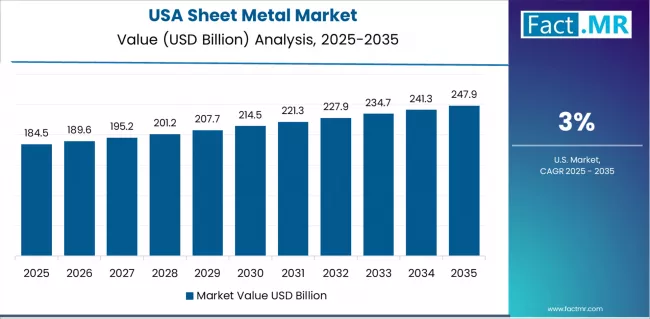
Revenue from sheet metal in the USA is projected to exhibit exceptional growth with a CAGR of 3.0% through 2035, driven by expanding infrastructure investment programs and comprehensive manufacturing sector development supported by domestic steel production capabilities and increasing focus on advanced fabrication technologies. The country's robust manufacturing base and infrastructure modernization programs are creating substantial demand for versatile sheet metal solutions. Major steel producers and fabrication companies are establishing comprehensive sheet metal processing capabilities to serve both domestic markets and export opportunities.
- Growing infrastructure investment and construction activities are driving demand for sheet metal throughout major construction projects and facility development across commercial, industrial, and transportation infrastructure applications nationwide.
- Strong automotive manufacturing and production capabilities are supporting sheet metal adoption among manufacturers seeking structural materials and component production solutions for diverse vehicle applications and transportation equipment.
- Advanced manufacturing technologies and automation integration are creating opportunities for high-precision sheet metal applications throughout major industrial centers and manufacturing facilities emphasizing quality and efficiency optimization.
- Expanding renewable energy development and grid modernization projects are driving demand for specialized sheet metal solutions supporting solar installations, wind energy systems, and electrical infrastructure applications.
Mexico Demonstrates Strong Market Potential with Automotive Manufacturing and Industrial Growth
Revenue from sheet metal in Mexico is expanding at a CAGR of 2.8%, supported by rapid automotive manufacturing expansion, growing construction industry development, and increasing investment in industrial projects supporting sheet metal integration across diverse manufacturing and construction applications. The country's expanding automotive production base and industrial modernization are driving sophisticated sheet metal utilization throughout automotive and construction sectors. Leading multinational companies and domestic manufacturers are establishing extensive sheet metal processing and fabrication capabilities.
- Rapid automotive manufacturing growth and expanding production capabilities are creating opportunities for sheet metal adoption throughout major automotive centers and supplier networks serving domestic and export markets including USMCA trade benefits.
- Growing construction industry and infrastructure development are driving sheet metal adoption among contractors and developers seeking reliable structural materials for commercial, residential, and industrial construction projects.
- Strategic geographic advantages and trade relationship benefits are supporting sheet metal market development including efficient supply chains, competitive manufacturing costs, and optimized access to North American automotive markets.
- Expanding industrial capabilities and workforce development programs are enabling advanced sheet metal processing technologies and specialized fabrication expertise throughout major manufacturing regions and industrial centers.
Germany Emphasizes Automotive Excellence with Engineering Innovation and Manufacturing Leadership
Revenue from sheet metal in Germany is expanding at a CAGR of 2.5%, supported by the country's automotive industry leadership, established engineering capabilities, and advanced manufacturing technologies supporting high-quality sheet metal applications. Germany's automotive excellence and engineering focus are supporting investment in sophisticated sheet metal solutions. Major automotive manufacturers and steel producers are establishing comprehensive development and processing capabilities for advanced sheet metal applications.
- Advanced automotive industry capabilities and engineering excellence are creating demand for high-performance sheet metal throughout major automotive centers and supplier networks emphasizing quality, precision, and performance optimization.
- Strong manufacturing innovation and precision fabrication expertise are driving the development of advanced sheet metal processing including automation integration, quality enhancement, and efficiency optimization throughout major manufacturing facilities.
- Comprehensive automotive engineering requirements and quality standards are advancing sheet metal applications including crashworthiness, lightweighting, and component integration throughout major automotive manufacturing operations.
- Export market leadership and international automotive reputation are enabling German sheet metal solutions to access global markets while maintaining premium positioning and engineering excellence advantages.
France Shows Automotive Strength with Construction Excellence and Manufacturing Innovation
Revenue from sheet metal in France is expanding at a CAGR of 2.3%, driven by automotive industry capabilities, established construction industry strength, and comprehensive manufacturing innovation programs supporting sheet metal development in automotive and construction applications. The country's industrial heritage and innovation focus are creating opportunities for sophisticated sheet metal utilization. Leading automotive companies and construction contractors are establishing comprehensive material optimization programs incorporating performance enhancement and cost efficiency.
- Strong automotive industry and manufacturing capabilities are creating demand for advanced sheet metal throughout major automotive centers and supplier networks supporting component production and vehicle assembly operations.
- Established construction industry excellence and infrastructure development are supporting sheet metal integration including structural applications, building systems, and architectural projects throughout major construction operations and development programs.
- Comprehensive manufacturing innovation and technology development are advancing sheet metal applications including processing optimization, quality enhancement, and automation integration throughout major industrial facilities and manufacturing centers.
- Premium manufacturing culture and quality excellence expectations are driving demand for superior sheet metal solutions supporting luxury automotive applications and high-performance construction projects throughout major industrial regions.
UK Demonstrates Manufacturing Innovation with Construction Modernization and Technology Development
Revenue from sheet metal in the UK is expanding at a CAGR of 2.1%, supported by comprehensive manufacturing modernization programs, established construction industry capabilities, and technology development initiatives emphasizing sheet metal integration for performance enhancement and operational optimization. The country's manufacturing heritage and innovation culture are driving sheet metal adoption throughout automotive and construction sectors. Leading manufacturing companies and construction contractors are establishing advanced fabrication and processing capabilities.
- Comprehensive manufacturing modernization and technology development are creating systematic market opportunities for sheet metal throughout major manufacturing centers and automotive companies emphasizing efficiency improvement and quality optimization.
- Strong construction industry capabilities and infrastructure modernization programs are supporting sheet metal development including building systems, infrastructure projects, and architectural applications throughout major construction operations.
- Advanced fabrication technologies and automation integration are enabling sheet metal processing optimization including precision manufacturing, quality enhancement, and efficiency improvement throughout major manufacturing facilities.
- Innovation in manufacturing technology and construction science is supporting sheet metal utilization enhancement including performance improvement, cost optimization, and sustainability integration throughout modern manufacturing and construction operations.
South Korea Emphasizes Industrial Excellence with Automotive Production and Shipbuilding Capabilities
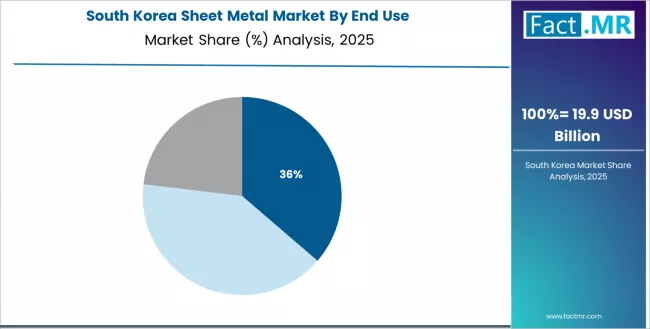
Revenue from sheet metal in South Korea is expanding at a CAGR of 2.0%, supported by comprehensive industrial manufacturing excellence, automotive production capabilities, and shipbuilding industry strength emphasizing sheet metal integration for manufacturing optimization and industrial development. The country's manufacturing excellence and technology focus are driving sophisticated sheet metal utilization in automotive and industrial applications. Leading manufacturing companies and industrial producers are establishing advanced sheet metal processing and fabrication capabilities.
- Comprehensive automotive production and manufacturing excellence are creating demand for sheet metal solutions throughout major automotive centers and manufacturing facilities emphasizing quality optimization and production efficiency.
- Advanced shipbuilding capabilities and industrial manufacturing are supporting sheet metal integration in diverse applications including marine construction, industrial equipment, and specialized manufacturing applications.
- Technology integration focus and manufacturing innovation are advancing sheet metal applications including processing optimization, quality enhancement, and automation integration throughout major industrial facilities and technology centers.
- Export manufacturing capabilities and international market presence are enabling South Korean sheet metal applications to serve global markets while maintaining quality standards and competitive positioning advantages.
Japan Shows Manufacturing Precision with Automotive Excellence and Steel Technology Innovation
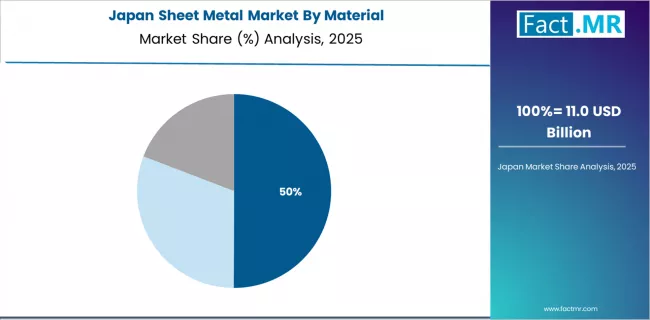
Revenue from sheet metal in Japan is expanding at a CAGR of 1.9%, driven by exceptional manufacturing precision standards, established automotive industry excellence, and comprehensive steel technology innovation emphasizing superior sheet metal quality and performance optimization. The country's commitment to manufacturing excellence and technology advancement are creating opportunities for ultra-high-quality sheet metal applications. Leading automotive manufacturers and steel companies are establishing comprehensive quality control and innovation programs.
- Exceptional automotive manufacturing standards and precision engineering capabilities are creating demand for ultra-high-quality sheet metal meeting Japanese automotive industry requirements for performance consistency and reliability.
- Advanced steel technology and metallurgical innovation are supporting sheet metal optimization including grade development, processing enhancement, and quality improvement throughout major steel production facilities and automotive applications.
- Comprehensive quality control systems and rigorous manufacturing standards are ensuring superior sheet metal consistency and reliability throughout major automotive manufacturing regions and precision industrial applications.
- Manufacturing innovation culture and continuous improvement focus are driving demand for sheet metal solutions that combine performance excellence with environmental responsibility and sustainable manufacturing practices.
Europe Market Split by Countries
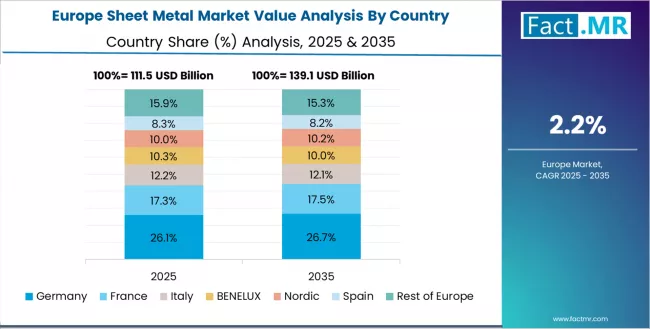
The sheet metal market in Europe is projected to grow from USD 129.0 billion in 2025 to USD 168.0 billion by 2035, registering a CAGR of 2.7% over the forecast period. Germany is expected to maintain leadership with a 28.5% market share in 2025, moderating to 28.2% by 2035, supported by automotive industry excellence, manufacturing capabilities, and advanced steel processing technologies.
France follows with 18.0% in 2025, projected at 18.2% by 2035, driven by automotive industry strength, construction capabilities, and manufacturing innovation programs. The United Kingdom holds 15.5% in 2025, expected to reach 15.7% by 2035 on the back of manufacturing modernization and construction industry development. Italy commands 13.0% in 2025, rising slightly to 13.1% by 2035, while Spain accounts for 11.5% in 2025, reaching 11.7% by 2035 aided by automotive development and construction growth. The Netherlands maintains 5.0% in 2025, up to 5.1% by 2035 due to advanced manufacturing capabilities and industrial technology focus. The Rest of Europe region, including Nordic countries, Central & Eastern Europe, and other markets, is anticipated to hold 8.5% in 2025 and 8.0% by 2035, reflecting steady growth in industrial development and manufacturing modernization.
Competitive Landscape of the Sheet Metal Market
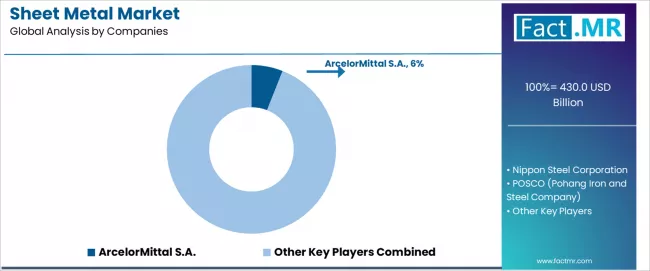
The sheet metal market is characterized by competition among established steel producers, integrated manufacturing companies, and specialized metal processing firms. Companies are investing in production technology development, capacity expansion programs, product grade innovation, and processing capability enhancement to deliver high-quality, cost-effective, and reliable sheet metal solutions. Innovation in steel grades, processing technologies, and sustainable production methods is central to strengthening market position and competitive advantage.
ArcelorMittal leads the market with a 6.0% share, offering comprehensive steel solutions with a focus on automotive applications, construction materials, and industrial products across diverse manufacturing, infrastructure, and transportation sectors. The company has announced major production capacity expansions and technology development programs, with plans to incorporate advanced steel grades and sustainable production technologies, with facility upgrades initiated in 2024 and enhanced capabilities planned for 2026. Nippon Steel provides innovative steel solutions with emphasis on automotive excellence, having advanced their sheet metal strategy by expanding high-strength steel production and developing specialized grades for advanced automotive applications.
POSCO delivers comprehensive steel solutions including advanced sheet metal products with focus on automotive and construction applications. Baowu Steel Group offers large-scale steel production with emphasis on domestic Chinese markets and export capabilities. JFE Steel provides specialized steel solutions with focus on automotive and industrial applications. Tata Steel focuses on integrated steel production and processing capabilities. Thyssenkrupp delivers steel solutions and processing technologies for diverse applications. United States Steel provides comprehensive steel production and processing services. JSW Steel offers steel solutions for automotive and construction markets. Hyundai Steel specializes in automotive steel applications and advanced processing capabilities.
Sheet Metal Market - Stakeholder Contribution Framework
Sheet metal represents a fundamental materials segment within manufacturing, construction, and industrial applications, projected to grow from USD 430.0 billion in 2025 to USD 560.0 billion by 2035 at a 2.7% CAGR. These processed steel products—primarily carbon steel, stainless steel, and aluminum materials—serve as critical manufacturing inputs in automotive production, construction projects, and industrial applications where structural strength, formability, and cost-effectiveness are essential. Market expansion is driven by increasing infrastructure development, growing automotive production, expanding manufacturing activities, and rising demand for versatile metal materials across diverse industrial and construction segments.
How Industrial Standards Organizations Could Strengthen Quality Standards and Performance Requirements
- Material Specifications and Quality Standards: Establish comprehensive technical specifications for sheet metal materials including mechanical properties, dimensional tolerances, and surface quality requirements that ensure consistent performance while enabling innovation and cost-effective manufacturing across diverse industrial applications.
- Safety Standards and Structural Requirements: Develop comprehensive safety criteria for sheet metal applications including structural design requirements, crashworthiness standards, and performance validation that ensure public safety while supporting engineering innovation and cost optimization.
- Environmental Standards and Sustainability Requirements: Create comprehensive environmental guidelines for steel production including emission standards, recycling requirements, and lifecycle assessment protocols that promote environmental responsibility while maintaining industrial competitiveness and economic viability.
- Testing and Certification Protocols: Implement standardized testing methodologies and certification procedures including mechanical testing, quality verification, and performance validation that ensure consistent material properties while enabling reliable product comparison and specification development.
- International Harmonization and Trade Facilitation: Facilitate global standards alignment including mutual recognition agreements, testing methodology coordination, and trade barrier reduction that support international commerce while maintaining high quality and safety standards.
How Manufacturing Industry Associations Could Advance Production Technologies and Market Development
- Technical Education and Professional Training: Develop comprehensive education programs for manufacturing professionals covering sheet metal processing, fabrication techniques, and quality assurance that enhance industry expertise while supporting successful project outcomes and manufacturing excellence.
- Production Technology Development and Best Practices: Create technical resources for sheet metal manufacturing including processing optimization, automation integration, and efficiency improvement that maximize production capabilities while maintaining quality standards and cost competitiveness.
- Market Development and Application Promotion: Support comprehensive marketing initiatives and application development programs that promote sheet metal utilization including technical education, market research, and customer development that expand market opportunities and support demand growth.
- Research and Development Collaboration: Facilitate partnerships between steel producers, manufacturing companies, research institutions, and end-user industries to advance processing technologies while accelerating innovation development and manufacturing optimization.
- Sustainability and Environmental Stewardship: Promote environmentally responsible manufacturing practices including energy efficiency improvement, waste reduction, and recycling optimization that address environmental concerns while maintaining competitive manufacturing and cost effectiveness.
How Sheet Metal Producers Could Drive Innovation and Market Leadership
- Advanced Production Technology and Manufacturing Excellence: Invest in state-of-the-art steel production equipment, processing optimization systems, and quality control technologies that improve product consistency while reducing costs and enhancing performance characteristics for competitive market positioning.
- Product Innovation and Specialized Grade Development: Develop comprehensive sheet metal portfolios including high-strength grades, specialized alloys, and application-specific formulations that address emerging market needs while maintaining cost competitiveness and processing efficiency.
- Sustainability and Environmental Responsibility: Implement environmentally responsible production practices including renewable energy integration, emission reduction programs, and circular economy principles that enhance sustainability credentials while supporting long-term market growth and regulatory compliance.
- Customer Partnership and Technical Support: Establish comprehensive support capabilities including application development, processing assistance, technical troubleshooting, and design optimization that strengthen customer relationships while enabling successful product implementation and market expansion.
- Global Operations and Supply Chain Optimization: Develop efficient production networks including strategic facility placement, supply chain integration, and distribution optimization that ensure reliable product availability while minimizing costs and supporting customer requirements worldwide.
How End-User Industries Could Optimize Sheet Metal Integration and Performance
- Strategic Material Selection and Performance Optimization: Develop comprehensive evaluation criteria for sheet metal materials including performance specifications, cost-benefit analysis, processing requirements, and supplier qualification that ensure optimal material selection while supporting application success and competitive positioning.
- Design Innovation and Manufacturing Efficiency: Implement systematic design approaches including performance modeling, fabrication optimization, and manufacturing efficiency enhancement that maximize sheet metal benefits while maintaining product functionality and cost competitiveness throughout development processes.
- Supply Chain Management and Quality Assurance: Establish comprehensive supplier relationships and quality control systems including specification management, delivery optimization, and consistency assurance that optimize material performance while maintaining manufacturing reliability and cost control.
- Sustainability Integration and Environmental Compliance: Incorporate environmental considerations into product development including recyclability optimization, carbon footprint assessment, and sustainable design principles that support sustainability objectives while maintaining performance and cost competitiveness.
- Innovation and Competitive Differentiation: Explore advanced sheet metal applications including novel designs, performance enhancements, and manufacturing optimization that provide competitive advantages while addressing market opportunities and customer requirements.
How Research Institutions Could Advance Materials Science and Technology Development
- Fundamental Metallurgy Research and Property Enhancement: Conduct comprehensive studies investigating steel chemistry, processing mechanisms, and property optimization that advance scientific understanding while informing technology development and material improvement across diverse manufacturing environments.
- Processing Technology Innovation and Manufacturing Optimization: Develop novel production methods including advanced rolling techniques, surface treatment technologies, and quality enhancement systems that improve manufacturing capabilities while reducing costs and environmental impact.
- Application Science and Performance Validation: Study sheet metal behavior in complex applications including automotive systems, construction environments, and industrial processes that enable optimized formulations while addressing performance challenges and application requirements.
- Sustainability Research and Environmental Impact: Investigate environmental effects of steel production and utilization including lifecycle assessment, recycling optimization, and emission reduction that support sustainable industry development and environmental stewardship.
- Technology Transfer and Commercialization Support: Facilitate innovation development through industry partnerships, licensing programs, and collaborative research initiatives that accelerate technology adoption while strengthening industry-academia cooperation and commercial application development.
How Investment Community Could Support Market Growth and Innovation Excellence
- Production Infrastructure and Capacity Investment: Provide capital for sheet metal production facility development, processing equipment acquisition, and capacity expansion projects that address growing market demand while improving operational efficiency and product quality standards.
- Technology Innovation and Manufacturing Advancement: Finance breakthrough steel technologies, processing innovations, and automation systems that advance industry capabilities while creating competitive advantages and efficiency benefits for long-term market success.
- Market Development and Geographic Expansion: Support market entry initiatives, distribution network development, and customer acquisition programs that increase market penetration while maintaining quality standards and operational excellence throughout expansion phases.
- Sustainability and Environmental Programs: Fund environmental responsibility initiatives including clean steel production, recycling technology development, and emission reduction programs that address environmental requirements while supporting market differentiation and regulatory compliance.
- Strategic Partnership and Integration Development: Provide capital for strategic alliances, vertical integration initiatives, and technology acquisitions that strengthen market position while enabling access to new capabilities, markets, and technologies for comprehensive business development.
Key Players in the Sheet Metal Market
- ArcelorMittal S.A.
- Nippon Steel Corporation
- POSCO (Pohang Iron and Steel Company)
- Baowu Steel Group Corporation
- JFE Steel Corporation
- Tata Steel Limited
- Thyssenkrupp AG
- United States Steel Corporation (U.S. Steel)
- JSW Steel Limited
- Hyundai Steel Company
Scope of the Report
| Items | Values |
|---|---|
| Quantitative Units (2025) | USD 430.0 Billion |
| Material | Carbon steel, Stainless steel, Aluminium & others |
| Process | Rolling, Pressing & stamping, Cutting & fabrication |
| End Use | Automotive & transport, Construction, Machinery & others |
| Regions Covered | North America, Europe, Asia Pacific, Latin America, Middle East & Africa |
| Countries Covered | USA, Mexico, Germany, France, UK, South Korea, Japan, and 40+ countries |
| Key Companies Profiled | ArcelorMittal, Nippon Steel, POSCO, Baowu Steel Group, JFE Steel, Tata Steel |
| Additional Attributes | Dollar sales by material and process category, regional demand trends, competitive landscape, technological advancements in steel production, manufacturing innovation, automotive applications, and industrial performance optimization |
Sheet Metal Market by Segments
-
Material :
- Carbon Steel
- Stainless Steel
- Aluminium & Others
-
Process :
- Rolling
- Pressing & Stamping
- Cutting & Fabrication
-
End Use :
- Automotive & Transport
- Construction
- Machinery & Others
-
Region :
-
North America
- United States
- Canada
- Mexico
-
Europe
- Germany
- United Kingdom
- France
- Italy
- Spain
- Netherlands
- Nordic
- Rest of Europe
-
Asia Pacific
- Japan
- South Korea
- China
- India
- Australia
- Rest of Asia Pacific
-
Latin America
- Brazil
- Argentina
- Rest of Latin America
-
Middle East & Africa
- Kingdom of Saudi Arabia
- Other GCC Countries
- South Africa
- Rest of Middle East & Africa
-
Table of Content
- Executive Summary
- Global Market Outlook
- Demand to side Trends
- Supply to side Trends
- Technology Roadmap Analysis
- Analysis and Recommendations
- Market Overview
- Market Coverage / Taxonomy
- Market Definition / Scope / Limitations
- Market Background
- Market Dynamics
- Drivers
- Restraints
- Opportunity
- Trends
- Scenario Forecast
- Demand in Optimistic Scenario
- Demand in Likely Scenario
- Demand in Conservative Scenario
- Opportunity Map Analysis
- Product Life Cycle Analysis
- Supply Chain Analysis
- Investment Feasibility Matrix
- Value Chain Analysis
- PESTLE and Porter’s Analysis
- Regulatory Landscape
- Regional Parent Market Outlook
- Production and Consumption Statistics
- Import and Export Statistics
- Market Dynamics
- Global Market Analysis 2020 to 2024 and Forecast, 2025 to 2035
- Historical Market Size Value (USD Million) Analysis, 2020 to 2024
- Current and Future Market Size Value (USD Million) Projections, 2025 to 2035
- Y to o to Y Growth Trend Analysis
- Absolute $ Opportunity Analysis
- Global Market Pricing Analysis 2020 to 2024 and Forecast 2025 to 2035
- Global Market Analysis 2020 to 2024 and Forecast 2025 to 2035, By Material
- Introduction / Key Findings
- Historical Market Size Value (USD Million) Analysis By Material , 2020 to 2024
- Current and Future Market Size Value (USD Million) Analysis and Forecast By Material , 2025 to 2035
- Carbon Steel
- Stainless Steel
- Aluminium & Others
- Y to o to Y Growth Trend Analysis By Material , 2020 to 2024
- Absolute $ Opportunity Analysis By Material , 2025 to 2035
- Global Market Analysis 2020 to 2024 and Forecast 2025 to 2035, By End Use
- Introduction / Key Findings
- Historical Market Size Value (USD Million) Analysis By End Use, 2020 to 2024
- Current and Future Market Size Value (USD Million) Analysis and Forecast By End Use, 2025 to 2035
- Automotive & Transport
- Construction
- Machinery & Others
- Y to o to Y Growth Trend Analysis By End Use, 2020 to 2024
- Absolute $ Opportunity Analysis By End Use, 2025 to 2035
- Global Market Analysis 2020 to 2024 and Forecast 2025 to 2035, By Region
- Introduction
- Historical Market Size Value (USD Million) Analysis By Region, 2020 to 2024
- Current Market Size Value (USD Million) Analysis and Forecast By Region, 2025 to 2035
- North America
- Latin America
- Western Europe
- Eastern Europe
- East Asia
- South Asia and Pacific
- Middle East & Africa
- Market Attractiveness Analysis By Region
- North America Market Analysis 2020 to 2024 and Forecast 2025 to 2035, By Country
- Historical Market Size Value (USD Million) Trend Analysis By Market Taxonomy, 2020 to 2024
- Market Size Value (USD Million) Forecast By Market Taxonomy, 2025 to 2035
- By Country
- USA
- Canada
- Mexico
- By Material
- By End Use
- By Country
- Market Attractiveness Analysis
- By Country
- By Material
- By End Use
- Key Takeaways
- Latin America Market Analysis 2020 to 2024 and Forecast 2025 to 2035, By Country
- Historical Market Size Value (USD Million) Trend Analysis By Market Taxonomy, 2020 to 2024
- Market Size Value (USD Million) Forecast By Market Taxonomy, 2025 to 2035
- By Country
- Brazil
- Chile
- Rest of Latin America
- By Material
- By End Use
- By Country
- Market Attractiveness Analysis
- By Country
- By Material
- By End Use
- Key Takeaways
- Western Europe Market Analysis 2020 to 2024 and Forecast 2025 to 2035, By Country
- Historical Market Size Value (USD Million) Trend Analysis By Market Taxonomy, 2020 to 2024
- Market Size Value (USD Million) Forecast By Market Taxonomy, 2025 to 2035
- By Country
- Germany
- UK
- Italy
- Spain
- France
- Nordic
- BENELUX
- Rest of Western Europe
- By Material
- By End Use
- By Country
- Market Attractiveness Analysis
- By Country
- By Material
- By End Use
- Key Takeaways
- Eastern Europe Market Analysis 2020 to 2024 and Forecast 2025 to 2035, By Country
- Historical Market Size Value (USD Million) Trend Analysis By Market Taxonomy, 2020 to 2024
- Market Size Value (USD Million) Forecast By Market Taxonomy, 2025 to 2035
- By Country
- Russia
- Poland
- Hungary
- Balkan & Baltic
- Rest of Eastern Europe
- By Material
- By End Use
- By Country
- Market Attractiveness Analysis
- By Country
- By Material
- By End Use
- Key Takeaways
- East Asia Market Analysis 2020 to 2024 and Forecast 2025 to 2035, By Country
- Historical Market Size Value (USD Million) Trend Analysis By Market Taxonomy, 2020 to 2024
- Market Size Value (USD Million) Forecast By Market Taxonomy, 2025 to 2035
- By Country
- China
- Japan
- South Korea
- By Material
- By End Use
- By Country
- Market Attractiveness Analysis
- By Country
- By Material
- By End Use
- Key Takeaways
- South Asia and Pacific Market Analysis 2020 to 2024 and Forecast 2025 to 2035, By Country
- Historical Market Size Value (USD Million) Trend Analysis By Market Taxonomy, 2020 to 2024
- Market Size Value (USD Million) Forecast By Market Taxonomy, 2025 to 2035
- By Country
- India
- ASEAN
- Australia & New Zealand
- Rest of South Asia and Pacific
- By Material
- By End Use
- By Country
- Market Attractiveness Analysis
- By Country
- By Material
- By End Use
- Key Takeaways
- Middle East & Africa Market Analysis 2020 to 2024 and Forecast 2025 to 2035, By Country
- Historical Market Size Value (USD Million) Trend Analysis By Market Taxonomy, 2020 to 2024
- Market Size Value (USD Million) Forecast By Market Taxonomy, 2025 to 2035
- By Country
- Kingdom of Saudi Arabia
- Other GCC Countries
- Turkiye
- South Africa
- Other African Union
- Rest of Middle East & Africa
- By Material
- By End Use
- By Country
- Market Attractiveness Analysis
- By Country
- By Material
- By End Use
- Key Takeaways
- Key Countries Market Analysis
- USA
- Pricing Analysis
- Market Share Analysis, 2024
- By Material
- By End Use
- Canada
- Pricing Analysis
- Market Share Analysis, 2024
- By Material
- By End Use
- Mexico
- Pricing Analysis
- Market Share Analysis, 2024
- By Material
- By End Use
- Brazil
- Pricing Analysis
- Market Share Analysis, 2024
- By Material
- By End Use
- Chile
- Pricing Analysis
- Market Share Analysis, 2024
- By Material
- By End Use
- Germany
- Pricing Analysis
- Market Share Analysis, 2024
- By Material
- By End Use
- UK
- Pricing Analysis
- Market Share Analysis, 2024
- By Material
- By End Use
- Italy
- Pricing Analysis
- Market Share Analysis, 2024
- By Material
- By End Use
- Spain
- Pricing Analysis
- Market Share Analysis, 2024
- By Material
- By End Use
- France
- Pricing Analysis
- Market Share Analysis, 2024
- By Material
- By End Use
- India
- Pricing Analysis
- Market Share Analysis, 2024
- By Material
- By End Use
- ASEAN
- Pricing Analysis
- Market Share Analysis, 2024
- By Material
- By End Use
- Australia & New Zealand
- Pricing Analysis
- Market Share Analysis, 2024
- By Material
- By End Use
- China
- Pricing Analysis
- Market Share Analysis, 2024
- By Material
- By End Use
- Japan
- Pricing Analysis
- Market Share Analysis, 2024
- By Material
- By End Use
- South Korea
- Pricing Analysis
- Market Share Analysis, 2024
- By Material
- By End Use
- Russia
- Pricing Analysis
- Market Share Analysis, 2024
- By Material
- By End Use
- Poland
- Pricing Analysis
- Market Share Analysis, 2024
- By Material
- By End Use
- Hungary
- Pricing Analysis
- Market Share Analysis, 2024
- By Material
- By End Use
- Kingdom of Saudi Arabia
- Pricing Analysis
- Market Share Analysis, 2024
- By Material
- By End Use
- Turkiye
- Pricing Analysis
- Market Share Analysis, 2024
- By Material
- By End Use
- South Africa
- Pricing Analysis
- Market Share Analysis, 2024
- By Material
- By End Use
- USA
- Market Structure Analysis
- Competition Dashboard
- Competition Benchmarking
- Market Share Analysis of Top Players
- By Regional
- By Material
- By End Use
- Competition Analysis
- Competition Deep Dive
- ArcelorMittal S.A.
- Overview
- Product Portfolio
- Profitability by Market Segments (Product/Age /Sales Channel/Region)
- Sales Footprint
- Strategy Overview
- Marketing Strategy
- Product Strategy
- Channel Strategy
- Nippon Steel Corporation
- POSCO (Pohang Iron and Steel Company)
- Baowu Steel Group Corporation
- JFE Steel Corporation
- Tata Steel Limited
- Thyssenkrupp AG
- Value (USD Million)ed States Steel Corporation (U.S. Steel)
- JSW Steel Limited
- Hyundai Steel Company
- ArcelorMittal S.A.
- Competition Deep Dive
- Assumptions & Acronyms Used
- Research Methodology
List Of Table
- Table 1: Global Market Value (USD Million) Forecast by Region, 2020 to 2035
- Table 2: Global Market Value (USD Million) Forecast by Material , 2020 to 2035
- Table 3: Global Market Value (USD Million) Forecast by End Use, 2020 to 2035
- Table 4: North America Market Value (USD Million) Forecast by Country, 2020 to 2035
- Table 5: North America Market Value (USD Million) Forecast by Material , 2020 to 2035
- Table 6: North America Market Value (USD Million) Forecast by End Use, 2020 to 2035
- Table 7: Latin America Market Value (USD Million) Forecast by Country, 2020 to 2035
- Table 8: Latin America Market Value (USD Million) Forecast by Material , 2020 to 2035
- Table 9: Latin America Market Value (USD Million) Forecast by End Use, 2020 to 2035
- Table 10: Western Europe Market Value (USD Million) Forecast by Country, 2020 to 2035
- Table 11: Western Europe Market Value (USD Million) Forecast by Material , 2020 to 2035
- Table 12: Western Europe Market Value (USD Million) Forecast by End Use, 2020 to 2035
- Table 13: Eastern Europe Market Value (USD Million) Forecast by Country, 2020 to 2035
- Table 14: Eastern Europe Market Value (USD Million) Forecast by Material , 2020 to 2035
- Table 15: Eastern Europe Market Value (USD Million) Forecast by End Use, 2020 to 2035
- Table 16: East Asia Market Value (USD Million) Forecast by Country, 2020 to 2035
- Table 17: East Asia Market Value (USD Million) Forecast by Material , 2020 to 2035
- Table 18: East Asia Market Value (USD Million) Forecast by End Use, 2020 to 2035
- Table 19: South Asia and Pacific Market Value (USD Million) Forecast by Country, 2020 to 2035
- Table 20: South Asia and Pacific Market Value (USD Million) Forecast by Material , 2020 to 2035
- Table 21: South Asia and Pacific Market Value (USD Million) Forecast by End Use, 2020 to 2035
- Table 22: Middle East & Africa Market Value (USD Million) Forecast by Country, 2020 to 2035
- Table 23: Middle East & Africa Market Value (USD Million) Forecast by Material , 2020 to 2035
- Table 24: Middle East & Africa Market Value (USD Million) Forecast by End Use, 2020 to 2035
List Of Figures
- Figure 1: Global Market Pricing Analysis
- Figure 2: Global Market Value (USD Million) Forecast 2020-2035
- Figure 3: Global Market Value Share and BPS Analysis by Material , 2025 and 2035
- Figure 4: Global Market Y to o to Y Growth Comparison by Material , 2025-2035
- Figure 5: Global Market Attractiveness Analysis by Material
- Figure 6: Global Market Value Share and BPS Analysis by End Use, 2025 and 2035
- Figure 7: Global Market Y to o to Y Growth Comparison by End Use, 2025-2035
- Figure 8: Global Market Attractiveness Analysis by End Use
- Figure 9: Global Market Value (USD Million) Share and BPS Analysis by Region, 2025 and 2035
- Figure 10: Global Market Y to o to Y Growth Comparison by Region, 2025-2035
- Figure 11: Global Market Attractiveness Analysis by Region
- Figure 12: North America Market Incremental Dollar Opportunity, 2025-2035
- Figure 13: Latin America Market Incremental Dollar Opportunity, 2025-2035
- Figure 14: Western Europe Market Incremental Dollar Opportunity, 2025-2035
- Figure 15: Eastern Europe Market Incremental Dollar Opportunity, 2025-2035
- Figure 16: East Asia Market Incremental Dollar Opportunity, 2025-2035
- Figure 17: South Asia and Pacific Market Incremental Dollar Opportunity, 2025-2035
- Figure 18: Middle East & Africa Market Incremental Dollar Opportunity, 2025-2035
- Figure 19: North America Market Value Share and BPS Analysis by Country, 2025 and 2035
- Figure 20: North America Market Value Share and BPS Analysis by Material , 2025 and 2035
- Figure 21: North America Market Y to o to Y Growth Comparison by Material , 2025-2035
- Figure 22: North America Market Attractiveness Analysis by Material
- Figure 23: North America Market Value Share and BPS Analysis by End Use, 2025 and 2035
- Figure 24: North America Market Y to o to Y Growth Comparison by End Use, 2025-2035
- Figure 25: North America Market Attractiveness Analysis by End Use
- Figure 26: Latin America Market Value Share and BPS Analysis by Country, 2025 and 2035
- Figure 27: Latin America Market Value Share and BPS Analysis by Material , 2025 and 2035
- Figure 28: Latin America Market Y to o to Y Growth Comparison by Material , 2025-2035
- Figure 29: Latin America Market Attractiveness Analysis by Material
- Figure 30: Latin America Market Value Share and BPS Analysis by End Use, 2025 and 2035
- Figure 31: Latin America Market Y to o to Y Growth Comparison by End Use, 2025-2035
- Figure 32: Latin America Market Attractiveness Analysis by End Use
- Figure 33: Western Europe Market Value Share and BPS Analysis by Country, 2025 and 2035
- Figure 34: Western Europe Market Value Share and BPS Analysis by Material , 2025 and 2035
- Figure 35: Western Europe Market Y to o to Y Growth Comparison by Material , 2025-2035
- Figure 36: Western Europe Market Attractiveness Analysis by Material
- Figure 37: Western Europe Market Value Share and BPS Analysis by End Use, 2025 and 2035
- Figure 38: Western Europe Market Y to o to Y Growth Comparison by End Use, 2025-2035
- Figure 39: Western Europe Market Attractiveness Analysis by End Use
- Figure 40: Eastern Europe Market Value Share and BPS Analysis by Country, 2025 and 2035
- Figure 41: Eastern Europe Market Value Share and BPS Analysis by Material , 2025 and 2035
- Figure 42: Eastern Europe Market Y to o to Y Growth Comparison by Material , 2025-2035
- Figure 43: Eastern Europe Market Attractiveness Analysis by Material
- Figure 44: Eastern Europe Market Value Share and BPS Analysis by End Use, 2025 and 2035
- Figure 45: Eastern Europe Market Y to o to Y Growth Comparison by End Use, 2025-2035
- Figure 46: Eastern Europe Market Attractiveness Analysis by End Use
- Figure 47: East Asia Market Value Share and BPS Analysis by Country, 2025 and 2035
- Figure 48: East Asia Market Value Share and BPS Analysis by Material , 2025 and 2035
- Figure 49: East Asia Market Y to o to Y Growth Comparison by Material , 2025-2035
- Figure 50: East Asia Market Attractiveness Analysis by Material
- Figure 51: East Asia Market Value Share and BPS Analysis by End Use, 2025 and 2035
- Figure 52: East Asia Market Y to o to Y Growth Comparison by End Use, 2025-2035
- Figure 53: East Asia Market Attractiveness Analysis by End Use
- Figure 54: South Asia and Pacific Market Value Share and BPS Analysis by Country, 2025 and 2035
- Figure 55: South Asia and Pacific Market Value Share and BPS Analysis by Material , 2025 and 2035
- Figure 56: South Asia and Pacific Market Y to o to Y Growth Comparison by Material , 2025-2035
- Figure 57: South Asia and Pacific Market Attractiveness Analysis by Material
- Figure 58: South Asia and Pacific Market Value Share and BPS Analysis by End Use, 2025 and 2035
- Figure 59: South Asia and Pacific Market Y to o to Y Growth Comparison by End Use, 2025-2035
- Figure 60: South Asia and Pacific Market Attractiveness Analysis by End Use
- Figure 61: Middle East & Africa Market Value Share and BPS Analysis by Country, 2025 and 2035
- Figure 62: Middle East & Africa Market Value Share and BPS Analysis by Material , 2025 and 2035
- Figure 63: Middle East & Africa Market Y to o to Y Growth Comparison by Material , 2025-2035
- Figure 64: Middle East & Africa Market Attractiveness Analysis by Material
- Figure 65: Middle East & Africa Market Value Share and BPS Analysis by End Use, 2025 and 2035
- Figure 66: Middle East & Africa Market Y to o to Y Growth Comparison by End Use, 2025-2035
- Figure 67: Middle East & Africa Market Attractiveness Analysis by End Use
- Figure 68: Global Market - Tier Structure Analysis
- Figure 69: Global Market - Company Share Analysis
- FAQs -
How big is the sheet metal market in 2025?
The global sheet metal market is estimated to be valued at USD 430.0 billion in 2025.
What will be the size of sheet metal market in 2035?
The market size for the sheet metal market is projected to reach USD 560.0 billion by 2035.
How much will be the sheet metal market growth between 2025 and 2035?
The sheet metal market is expected to grow at a 2.7% CAGR between 2025 and 2035.
What are the key product types in the sheet metal market?
The key product types in sheet metal market are carbon steel, stainless steel and aluminium & others.
Which end use segment to contribute significant share in the sheet metal market in 2025?
In terms of end use, automotive & transport segment to command 38.0% share in the sheet metal market in 2025.